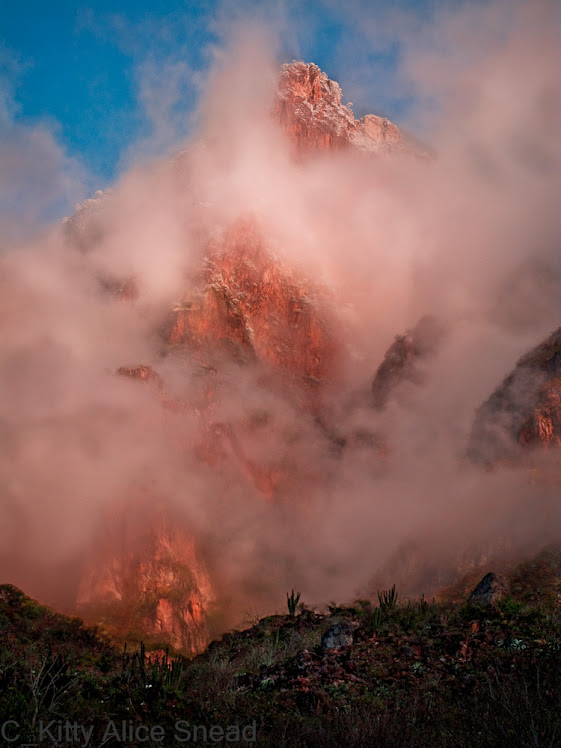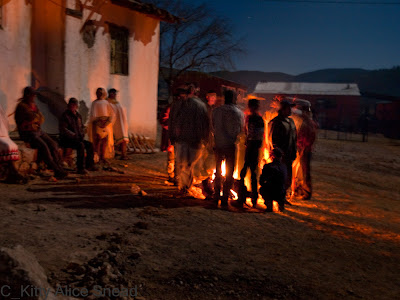As a girl I spent summers in the Mellon Gallery looking at the old, forgotten world of the “Dutch Masters.” I suppose I carry the memory of their use of light --candle light-- with me. Later in my travels I would find that same light again.
I began photographing the Tarahumara people of Northwestern Mexico in 1998 and continued to do so for ten years. I was drawn to their traditional way of living. Today, as in ancient times, their customs are passed down through oral tradition and in their own language, Raramuri. Living in remote areas of the Sierras the Tarahumara have kept their sense of community through a rich and colorful ritual life. The use of ritual marks and celebrates the passing of the seasons, which are so important in their agrarian lives.
 |
Fire Light was begun in 2007 during a Tutu Buri/Yumari celebration on a moonless, spring night out in the Mexican Sierras. I did not want to use a flash but the night was pitch-black except for scattered warming fires at the edge of the dance circle. I whined disappointedly at the lack of light. A fire was built for me just behind the Chapeyokos so that I could photograph their use of the mask. This was a project that I had begun for The Journal of the SouthWest out of the University of Arizona at Tucson.
I liked the tone captured by the camera in the firelight located so close to the Chapeyoko figures –mysterious larger than life images of masked figures. This series had the look and feel of the ritual I had experienced so many times before. The vexing question had always been, ‘how to move the fire around with me?’ My guide Santiago and I discussed this at length when it suddenly dawned on us to use the lanterns from the ball race to light the ritual of the dance. This would give me the mobility I so desperately wanted.
 Two years later I was again in the highlands for the Mate chine dance and Tutu Buri/ Yumari. Santiago packed in two modified ball lanterns for us. The people camped overnight in the village dancing, cooking and drinking throughout the night of Dec. 11th. The dancing continued into the morning of the 12th then the food was passed out to feed the community. Along with video footage, I shot the remainder of The Fire Light Series. Two or three days later another Tutu Buri/ Yumari took place in honor of a Tarahumara woman who had recently passed away. So I was able to photograph these night dances using fire as my light source. Many of the images were made possible by the ball lanterns we used.
Two years later I was again in the highlands for the Mate chine dance and Tutu Buri/ Yumari. Santiago packed in two modified ball lanterns for us. The people camped overnight in the village dancing, cooking and drinking throughout the night of Dec. 11th. The dancing continued into the morning of the 12th then the food was passed out to feed the community. Along with video footage, I shot the remainder of The Fire Light Series. Two or three days later another Tutu Buri/ Yumari took place in honor of a Tarahumara woman who had recently passed away. So I was able to photograph these night dances using fire as my light source. Many of the images were made possible by the ball lanterns we used. |
And the Tarahumara grew accustomed to my presence. When we lit the lanterns they laughed and asked if we were going to run a race! The lanterns were familiar and unobtrusive. Success!
 What began as an interest in “Native American “culture continued out of my growing respect for a people, who in the face of overwhelming odds continue to live their lives outside the mainstream comforts of the modern world. These people retain the skills and knowledge to survive in harsh conditions. My own culture has largely lost the sense of community. The community organization entrusted with governing and maintaining tradition also supports the individual in times of need. In short our families and communities are disunited. As individuals we no longer possess the skills to feed ourselves.
What began as an interest in “Native American “culture continued out of my growing respect for a people, who in the face of overwhelming odds continue to live their lives outside the mainstream comforts of the modern world. These people retain the skills and knowledge to survive in harsh conditions. My own culture has largely lost the sense of community. The community organization entrusted with governing and maintaining tradition also supports the individual in times of need. In short our families and communities are disunited. As individuals we no longer possess the skills to feed ourselves.As with Gilpin, the guide is the key into a hidden culture. Her friend was the reservation nurse. Mine is a rascal who walks the canyons and knows the trails and customs. Santiago is well known and respected with many friends and connections in the World of the Tarahumara. This work would have been impossible without him. And then I have to acknowledge another guide, Tim Boole, a talented photographer who has worked and taught Photoshop to photographers since its introduction. In the beginning, the New Mexican photographer Douglas Hall, taught me to see –to visualize a body of work and then move the concept through the necessary choices to produce the final image on the wall.
If you have time, this link shows a video of similar ritual celebrations. Tarahumara Ceremonies

